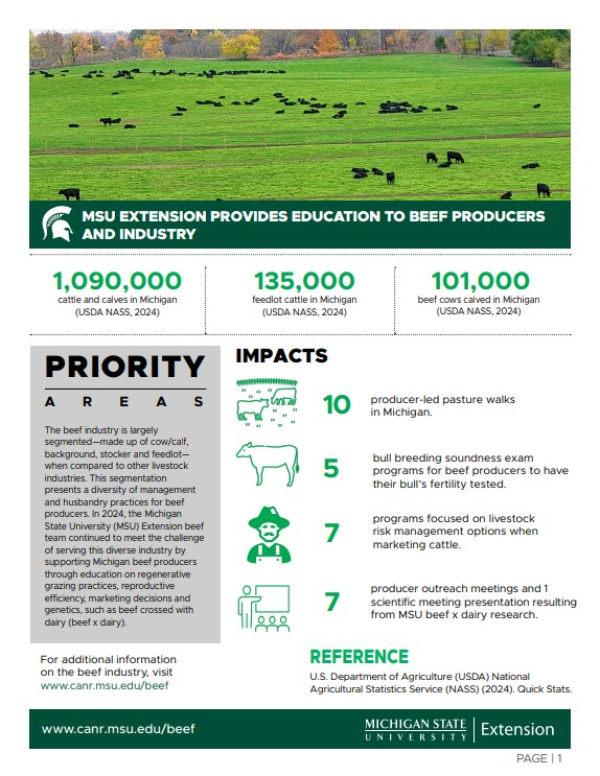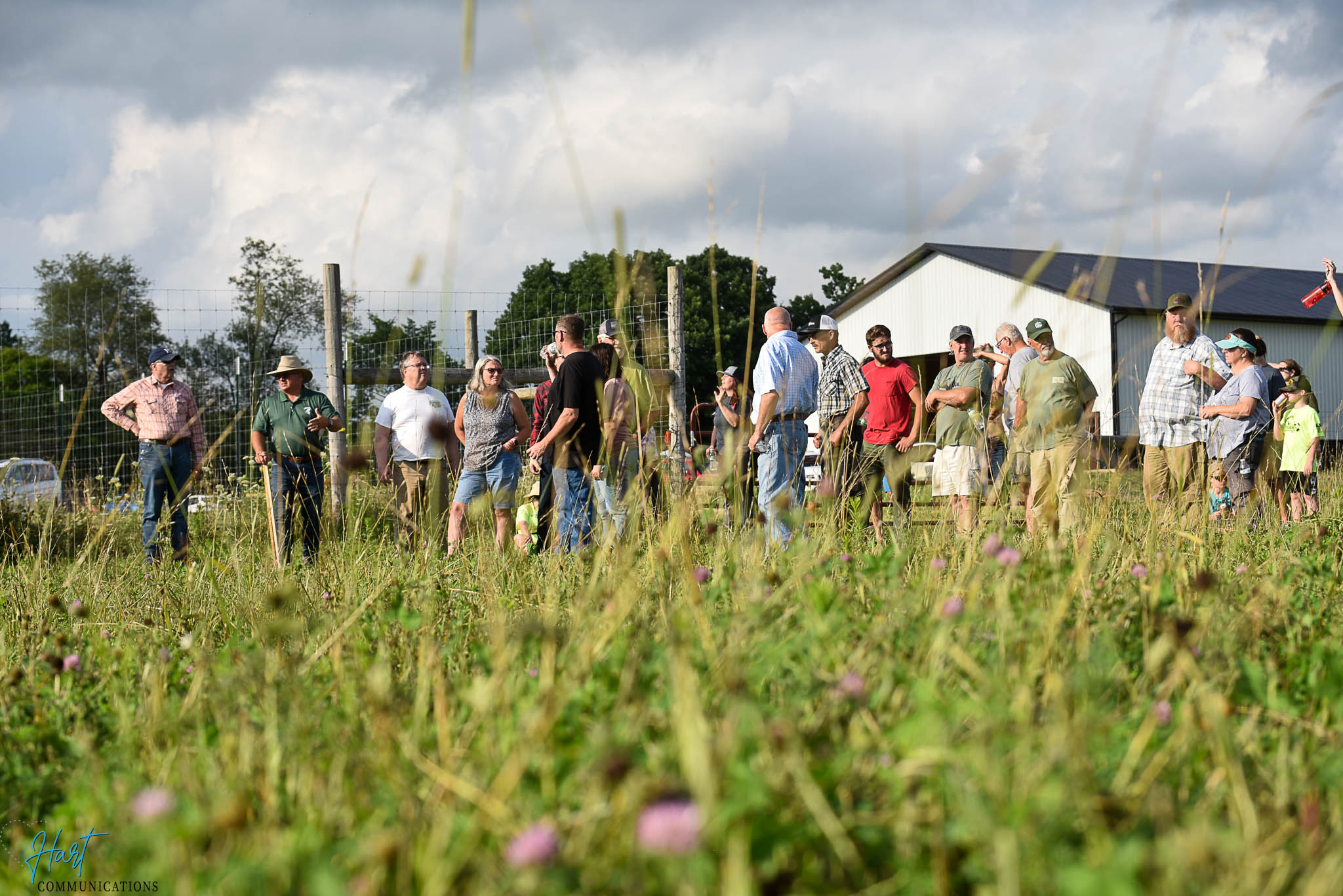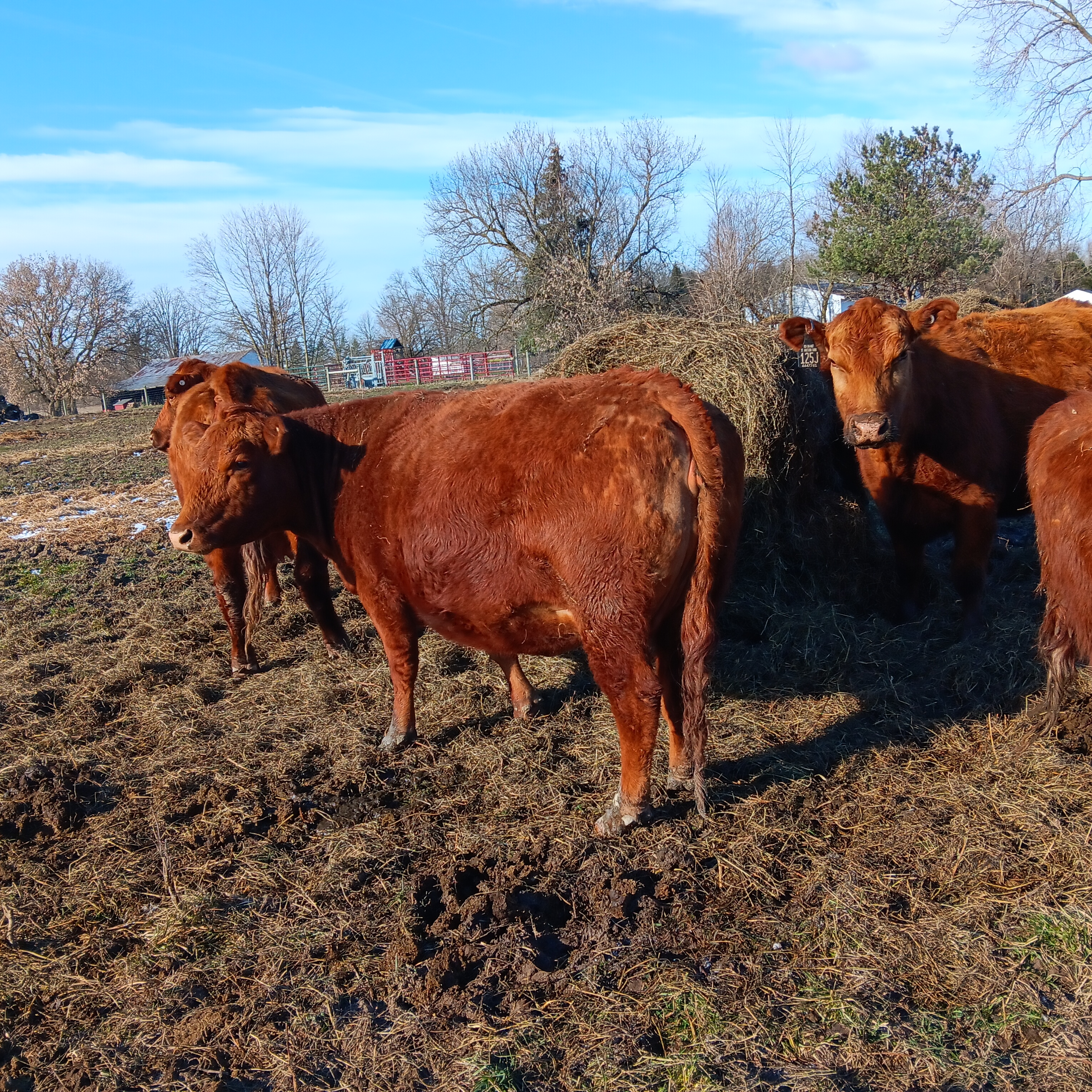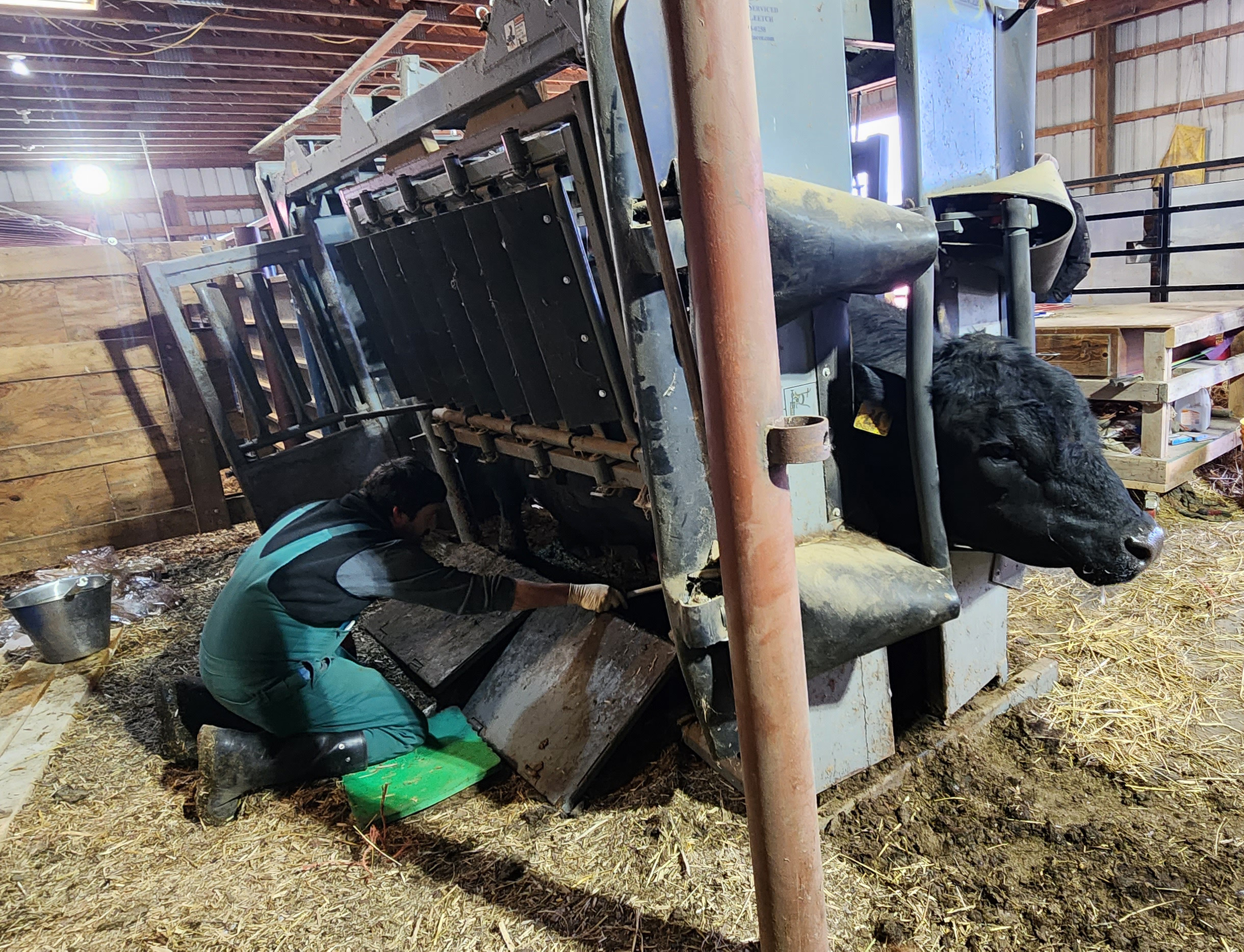
MSU Extension Provides Education to Beef Producers and Industry
DOWNLOADJune 19, 2025 - Michigan State University Extension
- 1,090,000 cattle and calves in Michigan (USDA NASS, 2024)
- 135,000 feedlot cattle in Michigan (USDA NASS, 2024)
- 101,000 beef cows calved in Michigan (USDA NASS 2024).
Priority Areas
The beef industry is largely segmented--made up of cow/calf, background, stocker and feedlot--when compared to other livestock industries. This segmentation presents a diversity of management and husbandry practices for beef producers. In 2024, the Michigan State University (MSU) Extension beef team continued to meet the challenge of serving this diverse industry by supporting Michigan beef producers through education or regenerative grazing practices, reproductive efficiency, marketing decisions and genetics, such as beef crossed with dairy (beef x dairy).
Impacts
- 10 producer-led pasture walks in Michigan
- 5 bull breeding soundness exam programs for beef producers to have their bull's fertility tested
- 7 programs focused on livestock risk management options when marketing cattle
- 7 producer outreach meetings and 1 scientific meeting presentation resulting from MSU beef x dairy research
Regenerative grazing and winter feeding for beef cows on pasture

Feeding costs typically account for the largest expense, ranging from 40 to 70% on beef cattle operations (USDA, 2022). Having beef cattle graze grass can be a cost effective feeding strategy compared with purchasing outside feed resources, while reducing labor costs incurred to feed cattle. Additionally, grazing takes advantage of beef cattle's unique ruminant digestive tract design that allows them to digest forages and absorb the necessary nutrients needed for maintenance and growth.
When stockpiled pasture is no longer available during winter, beef producers must resort to different feeding practices. For many Michigan beef producers, beef cows are typically fed in a barnyard or dry lot setting that is close to the main operation. When cattle are confined to a barnyard or dry lot, manure must be gathered and removed to utilize the nutrients from the manure as fertilizer. Manure application can be an effective practice for applying nutrients to fields and pastures, but it comes with additional costs such as labor, equipment and possibly land availability. Additionally, nutrient loss through leaching into the soil in dry lot confinement systems is a concern compared with concrete barnyard systems.
Conversely, alternatives such as feeding cattle out in the pasture (i.e. bale feeding, unrolling hay) allow for cattle to naturally distribute the nutrients from manure directly. Winter feeding sites can be selected based on pasture/field areas that have visibly less fertility and production via soil testing. Winter feeding sites should also avoid areas that tend to be wetter or near surface water. These selected winter feeding sites should be rotated over time to avoid nutrient concentration to only one area.
In 2024, MSU Extension facilitated pasture walks at 10 different farms across Michigan. MSU Extension pasture programs, or "pasture walks", showcase grazing and winter feeding methods taught at the MSU Beginner Grazing School through visits to different Michigan beef grazing operations. The goal is to teach new methods of grazing and bring awareness to practices designed to increase soil health and improve ecosystem function. Most program attendees agree that these pasture walks are educational and beneficial to their operation.

"This was awesome! Thank you for getting me on the list at the last minute. We just moved to Michigan about a year ago. Part of my goal since moving up here has been to get to know other folks in the community doing things similar to what we want to do here on our new farm. Seeing the operation was helpful; many of the things they're doing, we've done on a smaller scale, or I had been thinking about trying here. It was also really nice to meet a few other folks, and I'm hoping to get to know more of the community in the future." Pasture walk participant.
Beef bull breeding soundness exam clinics
Every year, the MSU Extension beef team arranges beef bull breeding soundness exam clinics across Michigan to encourage beef producers to have their bulls tested before the upcoming breeding season. Breeding soundness exams are conducted to determine if a bull is in healthy physical condition and fertile enough to breed cows. During the breeding soundness exam, a veterinarian will perform a regular physical examination of the bull, assess body condition score and pay particular attention to the eyes, feet, legs, scrotum and sheath of the bull. The veterinarian will collect and evaluate the semen sample under a microscope for sperm morphology and motility. Bulls will be awarded a pass or fail designation based on the percentage of morphologically correct and motile sperm cells, less than 70% and less than 30%, respectively. Bulls that fail their breeding soundness exam may be considered for a future retest, as new sperm cells are produced about every 60 days.
In 2024, MSU Extension organized five different clinics in Baraga, Clare, Ogemaw, Ontonagon, Remus and multiple sites in the bovine tuberculosis zone (Alcona, Alpena, and Oscoda). The MSU Extension breeding soundness exam clinics served 63 beef producers and tested 89 bulls. Of the bulls tested, 72 passed, one deferred, and 16 failed.
Conducting a breeding soundness exam for the bulls on a farm is an insurance policy that brings beef producers peace of mind. A bull breeding soundness exam typically costs around $100. An infertile bull can cost a producer their entire calf crop. This calf crop is expected income the farm needs to pay for maintaining the cow herd. With 500-pound calves selling for record prices of $3 per pound in 2023-2024, producers stand to lose $1,500 per missed calf.
Producer testimonials from one breeding soundness exam testing location in 2024 indicated three producers chose not to have their bulls undergo a breeding soundness exam the previous year, with one producer receiving less than 25% of the expected calf crop and the other two receiving zero calves. For the two producers who failed to produce any calves, they chose to sell their open cows that year.

"I wish I had understood the importance of testing bulls on an annual basis." Breeding soundness exam clinic participant.
Livestock risk protection when marketing cattle
Livestock Risk Protection (LRP) is a U.S. Department of Agriculture is federally insured program designed to insure and minimize risk for cattle producers against declining market prices. Producers can purchase Livestock Risk Protection (LRP) for both feeder and fed cattle on a per-head basis, covering up to 2,000 head. Coverage prices are selected based on the expected sale value of the cattle. If market prices fall, producers may receive a payment to cover the difference between the expected and actual value.
Beef educational meetings, where LRP options were presented, were held at three locations across the Upper Peninsula in Rudyard, Escanaba and Bruce Crossing. At these meetings, 20% of participants indicated they planned to use LRP in the near future to protect prices when marketing their feeder calves. In the second session of the MSU Feedlot Educational Series held in the Thumb, representatives from United Producers Inc. discussed financing, marketing and risk management opportunities for cattle producers.
Various risk management tools such as simple hedge contracts, put and call options, beef packer contracts and LRP insurance were discussed and thoroughly explained with examples. Several participants expressed interest in following up with United Producers Inc. after the program to discuss how the information shared could be used by their cattle operation in the future.
- 24 producers attended, with 100% of surveys received indicating an increase in knowledge
- 75% of survey responses indicated implementing these management practices would have a positive impact on the cattle operation
MSU beef x dairy research
The concept of breeding a portion of cows on dairy farms to beef bulls to create beef x dairy calves has become a widely adopted practice since 2017. Beef x dairy calves are expected to outperform straightbred dairy steers due to the influx of beef genetics and the potential to qualify for Certified Angus Beef premiums. However, there was little research data available to support these industry practices. Therefore, MSU conducted research at the MSU Beef Cattle Teaching and Research Center feedlot to study how these beef x dairy calves perform in the feedlot and contribute to the beef supply. The first research study with beef x dairy calves (Phase I) compared Holstein and beef x Holstein steer feedlot performance (e.g., average daily gain, feed efficiency), carcass characteristics (e.g., carcass yield and quality) and economic revenue (e.g., cost of gain, breakeven price). The results from Phase I demonstrated the improved average daily gain and feed efficiency of beef x Holstein steers compared with straightbred Holsteins. Beef x Holstein steers had a greater amount of muscle and were cheaper to raise compared with Holstein steers. Results from Phase I were published in the Applied Animal Science Journal (doi.org/10.15232/aas.2023-02454). In 2024, results from Phase I were shared at Extension meetings, including two programs in Michigan (78 participants), one program in Iowa, four programs in Wisconsin (27 participants), one program in Oklahoma (80 participants) and one virtual program (34 participants) in the Great Lakes region. Survey data (100%) from a Michigan meeting indicated this topic should be considered for future presentations. A second research project comparing beef x dairy calves to Holstein steers, fed different inclusion rates of corn silage in the finishing diet, and the impacts on liver health is nearing completion. Meanwhile, a third research project involving beef x dairy cattle is underway at the MSU Beef Cattle Teaching and Research Center, continuing the investigation into raising beef x dairy cattle and how they fit in the U.S. beef supply.
"Interesting topic, relevant and impactful, educational, well-presented, good research." Beef x dairy research meeting participant.



 Print
Print Email
Email




